Design of a Multipurpose Photonic Chip Architecture for THz Dual-Comb Spectrometers
Abstract
1. Introduction
2. TDCS Architecture
2.1. Comb Source Stage
2.2. Comb Line Selection Stage
2.3. Frequency Shifting and Dual-Comb Stage
3. Simulation Results
4. Conclusions
Author Contributions
Funding
Acknowledgments
Conflicts of Interest
References
- Wietzke, S.; Rütz, F.; Jördens, C.; Krumbholz, N.; Vieweg, N.; Jansen, C.; Wilk, R.; Koch, M. Applications of terahertz spectroscopy in the plastics industry. Terahertz Photonics 2007, 6840, 68400V. [Google Scholar] [CrossRef]
- Naftaly, M.; Vieweg, N.; Deninger, A. Industrial Applications of Terahertz Sensing: State of Play. Sensors 2019, 19, 4203. [Google Scholar] [CrossRef] [PubMed]
- Petrov, V.; Pyattaev, A.; Moltchanov, D.; Koucheryavy, Y. Terahertz band communications: Applications, research challenges, and standardization activities. In Proceedings of the 2016 8th International Congress on Ultra Modern Telecommunications and Control Systems and Workshops (ICUMT), Lisbon, Portugal, 18–20 October 2016; pp. 183–190. [Google Scholar] [CrossRef]
- Sun, Q.; He, Y.; Liu, K.; Fan, S.; Parrott, E.P.J.; Pickwell-MacPherson, E. Recent advances in terahertz technology for biomedical applications. Quant. Imaging Med. Surg. 2017, 7, 345–355. [Google Scholar] [CrossRef] [PubMed]
- Kemp, M.C.; Taday, P.F.; Cole, B.E.; Cluff, J.A.; Fitzgerald, A.J.; Tribe, W.R. Security Applications of Terahertz Technology. In Terahertz for Military and Security Applications; Hwu, R.J., Woolard, D.L., Eds.; SPIE: Orlando, FL, UAS, 2003; Volume 5070, p. 44. [Google Scholar] [CrossRef]
- Pawar, A.Y.; Sonawane, D.D.; Erande, K.B.; Derle, D.V. Terahertz technology and its applications. Drug Inven. Today 2013, 5, 157–163. [Google Scholar] [CrossRef]
- Naftaly, M.; Foulds, A.P.; Miles, R.E.; Davies, A.G. Terahertz Transmission Spectroscopy of Nonpolar Materials and Relationship with Composition and Properties. Int. J. Infrared Millim. Waves 2005, 26, 55–64. [Google Scholar] [CrossRef]
- Yang, X.; Zhao, X.; Yang, K.; Liu, Y.; Liu, Y.; Fu, W.-L.; Luo, Y. Biomedical Applications of Terahertz Spectroscopy and Imaging. Trends Biotechnol. 2016, 34, 810–824. [Google Scholar] [CrossRef] [PubMed]
- Skvortsov, L.A. Standoff Detection of Hidden Explosives and Cold and Fire Arms by Terahertz Time-Domain Spectroscopy and Active Spectral Imaging (Review). J. Appl. Spectrosc. 2014, 81, 725–749. [Google Scholar] [CrossRef]
- Schiller, S. Spectrometry with frequency combs. Opt. Lett. 2002, 27, 766–768. [Google Scholar] [CrossRef]
- Villares, G.; Hugi, A.; Blaser, S.; Faist, J. Dual-comb spectroscopy based on quantum-cascade-laser frequency combs. Nat. Commun. 2014, 5, 5192. [Google Scholar] [CrossRef]
- Villares, G.; Wolf, J.; Kazakov, D.; Süess, M.J.; Hugi, A.; Beck, M.; Faist, J. On-chip dual-comb based on quantum cascade laser frequency combs. Appl. Phys. Lett. 2015, 107, 251104. [Google Scholar] [CrossRef]
- Westberg, J.; Sterczewski, L.A.; Kapsalidis, F.; Bidaux, Y.; Wolf, J.; Beck, M.; Faist, J.; Wysocki, G. Quantum Cascade Laser-Based Dual-Comb Spectroscopy in the Mid-Infrared. In Proceedings of the 2018 Conference Lasers Electro-Optics, CLEO 2018-Proc, San Jose, CA, USA, 13−18 May 2018; pp. 5–6. [Google Scholar]
- Fujita, K.; Hitaka, M.; Ito, A.; Yamanishi, M.; Dougakiuchi, T.; Edamura, T. Ultra-broadband room-temperature terahertz quantum cascade laser sources based on difference frequency generation. Opt. Express 2016, 24, 16357. [Google Scholar] [CrossRef] [PubMed]
- Good, J.T.; Holland, D.; Finneran, I.A.; Carroll, P.B.; Kelley, M.W.; Blake, G.A. A decade-spanning high-resolution asynchronous optical sampling terahertz time-domain and frequency comb spectrometer. Rev. Sci. Instrum. 2015, 86, 103107. [Google Scholar] [CrossRef]
- Jerez, B.; Walla, F.; Betancur, A.; Martin-Mateos, P.; De Dios, C.; Acedo, P. Electro-optic THz dual-comb architecture for high-resolution, absolute spectroscopy. Opt. Lett. 2019, 44, 415–418. [Google Scholar] [CrossRef] [PubMed]
- Martín-Mateos, P.; Jerez, B.; Betancur, A.; De Dios, C.; Acedo, P. Absolute-frequency THz dual-comb instrument: A scalable and high-resolution spectrometer based on electro-optic comb generation. Opt. Sens. Sens. Congr. 2019, FW5B.7. [Google Scholar] [CrossRef]
- Jerez, B.; Betancur, A.; Martín-Mateos, P.; De Dios, C.; Acedo, P. Multi-Octave Spanning, Absolute Frequency, High Resolution THz Dual-Comb Spectrometer Based on Electro-Optic Modulators: First Spectroscopic Measurements. Opt. InfoBase Conf. Pap. Singapore 2018, 7–8. [Google Scholar] [CrossRef]
- De Dios, C.; Martin-Mateos, P.; Jerez, B.; Betancur, A.; Barreiro, R.; Acedo, P. Dynamic THz dual-comb spectrometer: An optoelectronic fast interrogation approach. In Proceedings of the Conference on Lasers and Electro-Optics, Washington, DC, USA, 10−15 May 2020. [Google Scholar]
- Izutsu, M.; Shikama, S.; Sueta, T. Integrated optical SSB modulator/frequency shifter. IEEE J. Quantum Electron. 1981, 17, 2225–2227. [Google Scholar] [CrossRef]
- Deninger, A. State-of-the-art in terahertz continuous-wave photomixer systems. In Handbook of Terahertz Technology for Imaging, Sensing and Communications; Elsevier Inc.: Amsterdam, The Netherlands, 2013; pp. 327–373. [Google Scholar]
- Ito, H.; Nakajima, F.; Ohno, T.; Furuta, T.; Nagatsuma, T.; Ishibashi, T. InP-Based Planar-Antenna-Integrated Schottky-Barrier Diode for Millimeter- and Sub-Millimeter-Wave Detection. Jpn. J. Appl. Phys. 2008, 47, 6256–6261. [Google Scholar] [CrossRef]
- Gutiérrez, J.; Zeljami, K.; Fernández, T.; Pascual, J.P.; Tazon, A. Accurately Modeling of Zero Biased Schottky-Diodes at Millimeter-Wave Frequencies. Electronics 2019, 8, 696. [Google Scholar] [CrossRef]
- Yardimci, N.T.; Jarrahi, M. High Sensitivity Terahertz Detection through Large-Area Plasmonic Nano-Antenna Arrays. Sci. Rep. 2017, 7, 42667. [Google Scholar] [CrossRef]
- Ali, M.; Guzman, R.C.; Rivera-Lavado, A.; Cojocari, O.; Garcia-Mufioz, L.E.; Carpintero, G. Quasi-Optical Schottky Barrier Diode Detector for mmWave/sub-THz Wireless Communication. In Proceedings of the 2018 25th International Conference on Telecommunications (ICT), St. Malo, France, 26–28 June 2018; pp. 279–282. [Google Scholar]
- Liu, H.; Yu, J.; Huggard, P.; Alderman, B. A Multichannel THz Detector Using Integrated Bow-Tie Antennas. Int. J. Antennas Propag. 2013, 2013, 1–8. [Google Scholar] [CrossRef]
- Han, R.; Zhang, Y.; Kim, Y.; Shichijo, H.; Afshari, E. Active Terahertz Imaging Using Schottky Diodes in CMOS: Array and 860-GHz Pixel. IEEE J. Solid State Circuits 2013, 48, 2296–2308. [Google Scholar] [CrossRef]
- Andriolli, N.; Cassese, T.; Chiesa, M.; De Dios, C.; Contestabile, G. Photonic Integrated Fully Tunable Comb Generator Cascading Optical Modulators. J. Light. Technol. 2018, 36, 5685–5689. [Google Scholar] [CrossRef]
- Akiyama, S.; Itoh, H.; Sekiguchi, S.; Hirose, S.; Takeuchi, T.; Kuramata, A.; Yamamoto, T. InP-Based Mach–Zehnder Modulator With Capacitively Loaded Traveling-Wave Electrodes. J. Light. Technol. 2008, 26, 608–615. [Google Scholar] [CrossRef]
- Pascher, W.; Den Besten, J.H.; Caprioli, D.; Leijtens, X.; Smit, M.; Van Dijk, R. Modelling and Design of a Travelling-Wave Electro-Optic Modulator on InP. Opt. Quantum Electron. 2003, 35, 453–464. [Google Scholar] [CrossRef]
- Ogiso, Y.; Ozaki, J.; Ueda, Y.; Kashio, N.; Kikuchi, N.; Yamada, E.; Tanobe, H.; Kanazawa, S.; Yamazaki, H.; Ohiso, Y.; et al. Over 67 GHz Bandwidth and 1.5 V Vπ InP-Based Optical IQ Modulator With n-i-p-n Heterostructure. J. Light. Technol. 2017, 35, 1450–1455. [Google Scholar] [CrossRef]
- Madsen, C.K.; Zhao, J.H. Optical Filter Design and Analysis: A Signal Processing Approach; Wiley Series in Microwave and Optical Engineering; John Wiley & Sons, Inc.: New York, NY, USA, 1999. [Google Scholar] [CrossRef]
- Madsen, C. Efficient architectures for exactly realizing optical filters with optimum bandpass designs. IEEE Photon Technol. Lett. 1998, 10, 1136–1138. [Google Scholar] [CrossRef]
- Zhuang, L.; Hoekman, M.; Oldenbeuving, R.M.; Boller, K.-J.; Roeloffzen, C.G.H. CRIT-Alternative Narrow-Passband Waveguide Filter for Microwave Photonic Signal Processors. IEEE Photon Technol. Lett. 2014, 26, 1034–1037. [Google Scholar] [CrossRef]
- Rasras, M.S.; Gill, D.M.; Patel, S.S.; Tu, K.-Y.; Chen, Y.-K.; White, A.E.; Pomerene, A.T.; Carothers, D.N.; Grove, M.J.; Sparacin, D.K.; et al. Demonstration of a Fourth-Order Pole-Zero Optical Filter Integrated Using CMOS Processes. J. Light. Technol. 2007, 25, 87–92. [Google Scholar] [CrossRef]
- Safian, R.; Ghazi, G.; Mohammadian, N. Review of photomixing continuous-wave terahertz systems and current application trends in terahertz domain. Opt. Eng. 2019, 58, 110901. [Google Scholar] [CrossRef]
- Orlandi, P.; Morichetti, F.; Strain, M.; Sorel, M.; Bassi, P.; Melloni, A. Photonic Integrated Filter with Widely Tunable Bandwidth. J. Light. Technol. 2013, 32, 897–907. [Google Scholar] [CrossRef]
- Smit, M.; Williams, K.; Van Der Tol, J. Past, present, and future of InP-based photonic integration. APL Photon 2019, 4, 050901. [Google Scholar] [CrossRef]
- Guzzon, R.S.; Norberg, E.J.; Parker, J.S.; Coldren, L.A. Highly Programmable Optical Filters Integrated in InP- InGaAsP with Tunable Inter-Ring Coupling. Adv. Photonics 2010, 5–7. [Google Scholar] [CrossRef]
- Zhang, W.; Yao, J. A fully reconfigurable waveguide Bragg grating for programmable photonic signal processing. Nat. Commun. 2018, 9, 1396. [Google Scholar] [CrossRef] [PubMed]
- Zhu, T.; Hu, Y.; Gatkine, P.; Veilleux, S.; Bland-Hawthorn, J.; Dagenais, M. Arbitrary on-chip optical filter using complex waveguide Bragg gratings. Appl. Phys. Lett. 2016, 108, 101104. [Google Scholar] [CrossRef]
- Klimov, N.N.; Purdy, T.; Ahmed, Z. Fabrication and Characterization of On-Chip Integrated Silicon Photonic Bragg Grating and Photonic Crystal Cavity Thermometers. arXiv 2015, arXiv:1508.01419. [Google Scholar]
- Klitis, C.; Sorel, M.; Strain, M. Active On-Chip Dispersion Control Using a Tunable Silicon Bragg Grating. Micromachines 2019, 10, 569. [Google Scholar] [CrossRef]
- Docter, B.; Geluk, E.; Sander-Jochem, M.; Karouta, F.; Smit, M. Deep Etched DBR Gratings in InP for Photonic Integrated Circuits. In Proceedings of the 2007 IEEE 19th International Conference on Indium Phosphide & Related Materials, Matsue, Japan, 14–18 May 2007; pp. 226–228. [Google Scholar] [CrossRef]
- Lee, S.-L.; Lu, T.-C.; Hung, Y.-J.; Chen, L.-R.; Huang, Z.-T. Photonic integrated multiwavelength laser arrays: Recent progress and perspectives. Appl. Phys. Lett. 2020, 116, 180501. [Google Scholar] [CrossRef]
- Criado, A.R.; De Dios, C.; Prior, E.; Döhler, G.H.; Preu, S.; Malzer, S.; Lu, H.; Gossard, A.C.; Acedo, P. Continuous-Wave Sub-THz Photonic Generation with Ultra-Narrow Linewidth, Ultra-High Resolution, Full Frequency Range Coverage and High Long-Term Frequency Stability. IEEE Trans. Terahertz Sci. Technol. 2013, 3, 461–471. [Google Scholar] [CrossRef]
- Bałakier, K.; Fice, M.J.; Van Dijk, F.; Kervella, G.; Carpintero, G.; Seeds, A.J.; Renaud, C.C. Optical injection locking of monolithically integrated photonic source for generation of high purity signals above 100 GHz. Opt. Express 2014, 22, 29404–29412. [Google Scholar] [CrossRef]
- Shoji, Y.; Mizumoto, T. Silicon Waveguide Optical Isolator with Directly Bonded Magneto-Optical Garnet. Appl. Sci. 2019, 9, 609. [Google Scholar] [CrossRef]
- Bałakier, K.; Shams, H.; Fice, M.J.; Ponnampalam, L.; Graham, C.; Renaud, C.C.; Seeds, A.J. Optical Phase Lock Loop as High-Quality Tuneable Filter for Optical Frequency Comb Line Selection. J. Light. Technol. 2018, 36, 4646–4654. [Google Scholar] [CrossRef]
- Lauermann, M.; Weimann, C.; Knopf, A.; Heni, W.; Palmer, R.; Koeber, S.; Elder, D.L.; Bogaerts, W.; Leuthold, J.; Dalton, L.R.; et al. Integrated optical frequency shifter in silicon-organic hybrid (SOH) technology. Opt. Express 2016, 24, 11694. [Google Scholar] [CrossRef] [PubMed]
- Barretto, E.C.S.; Hvam, J.M. Photonic integrated single-sideband modulator/frequency shifter based on surface acoustic waves. Photonics Eur. 2010, 7719, 771920. [Google Scholar] [CrossRef]
- Spuesens, T.; Li, Y.; Verheyen, P.; Lepage, G.; Balakrishnan, S.; Absil, P.; Baets, R.G.F. Integrated Optical Frequency Shifter on a Silicon Platform. CLEO 2016, 2, 3–4. [Google Scholar] [CrossRef]
- Yu, X.; Zhang, H.; Zheng, X. High carrier suppression double sideband modulation using polarization state rotation filter and optical external modulator. Opt. Commun. 2006, 267, 83–87. [Google Scholar] [CrossRef]
- Martín-Mateos, P.; Čibiraitė-Lukenskienė, D.; Barreiro, R.; De Dios, C.; Lisauskas, A.; Krozer, V.; Acedo, P. Hyperspectral terahertz imaging with electro-optic dual combs and a FET-based detector. Sci. Rep. 2020, 10, 1–7. [Google Scholar] [CrossRef]
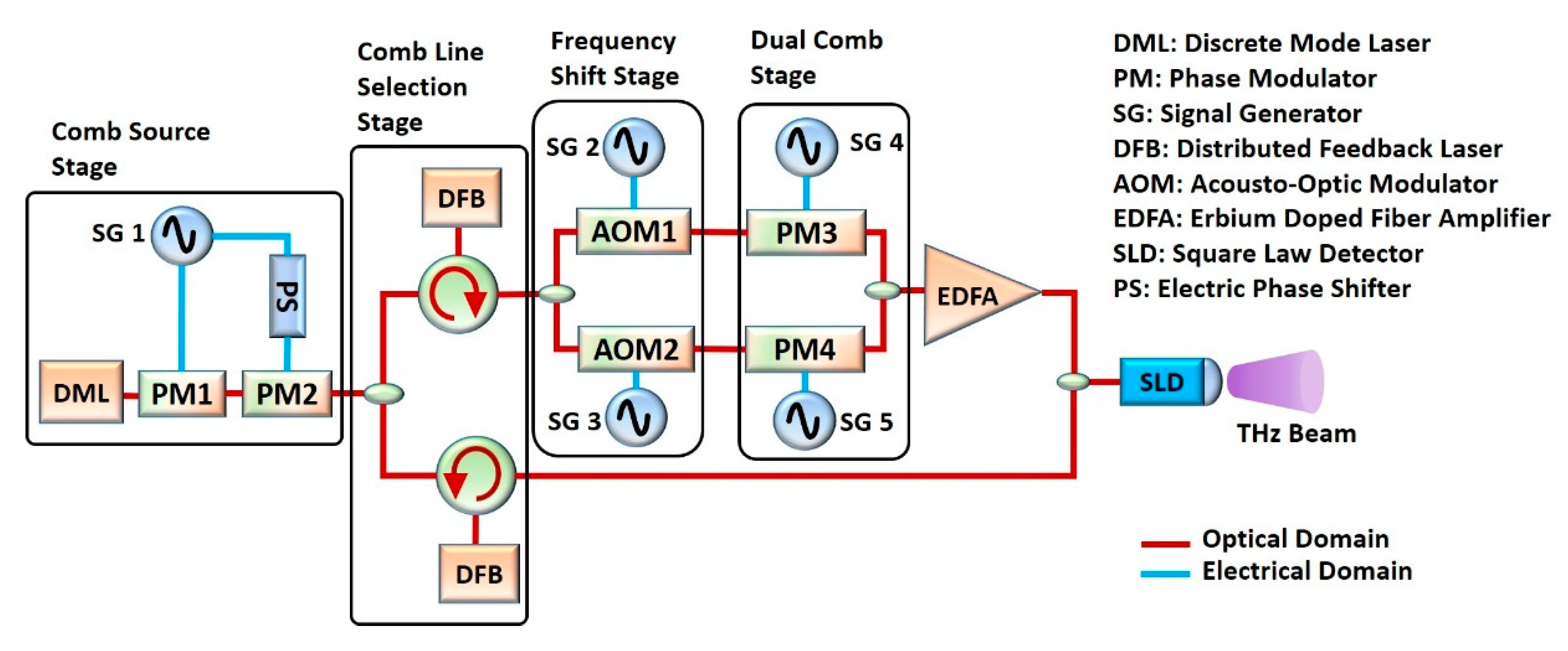
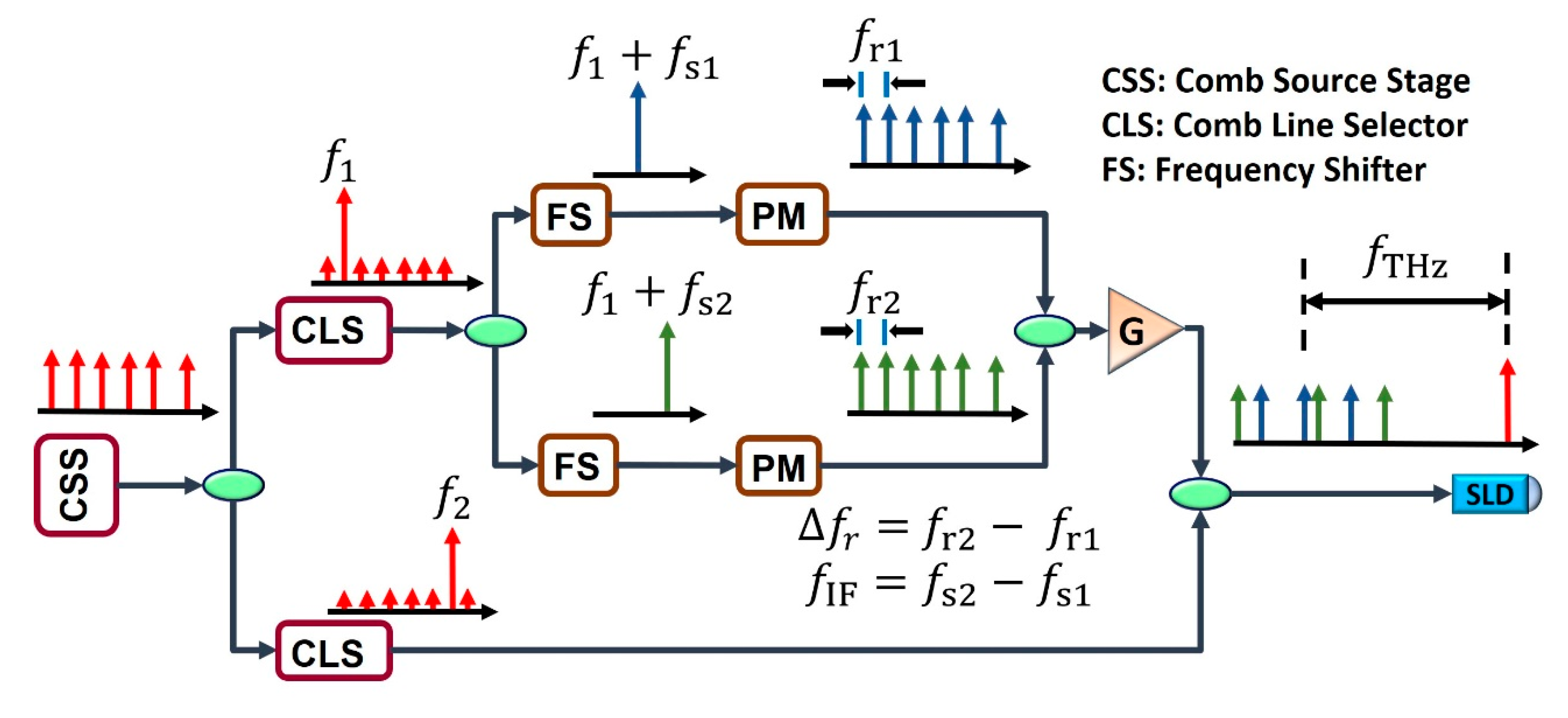
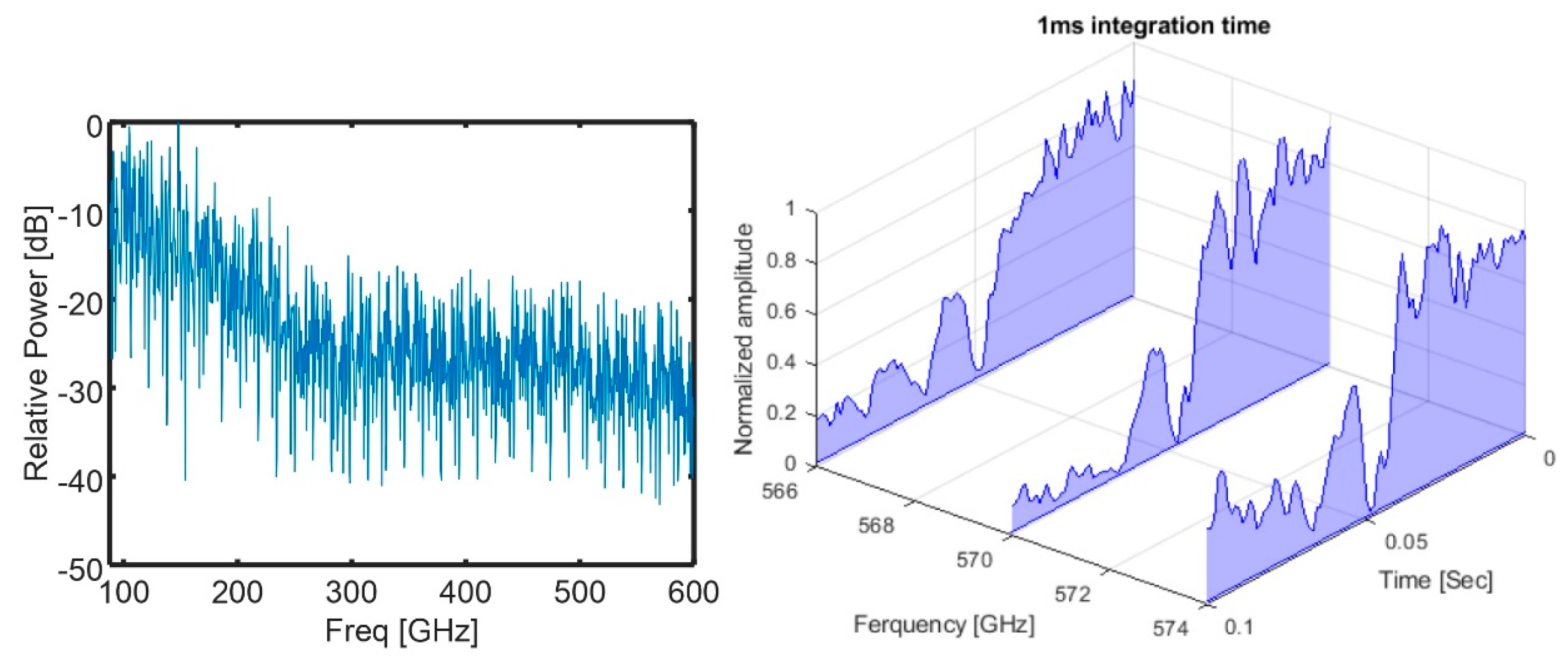
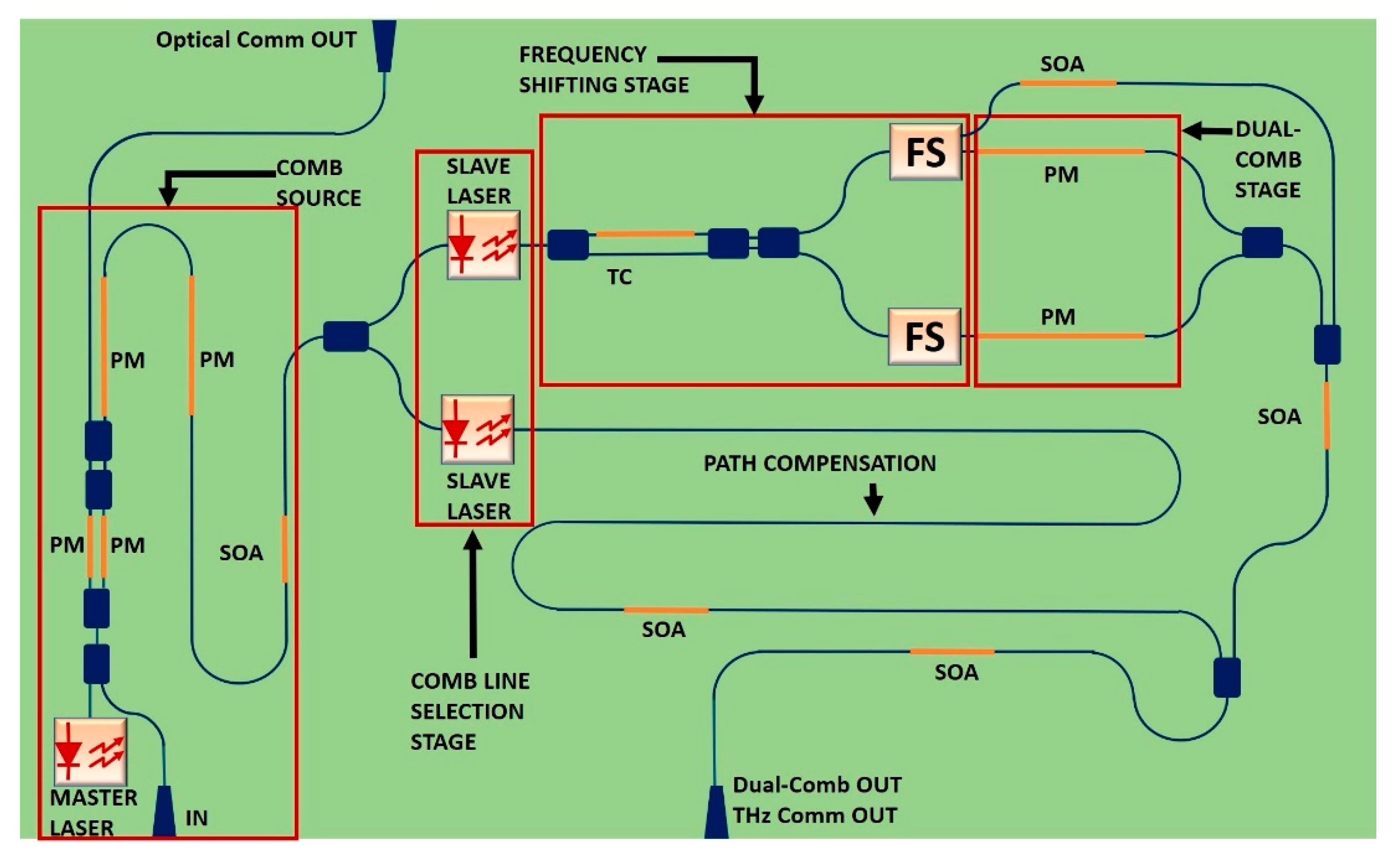

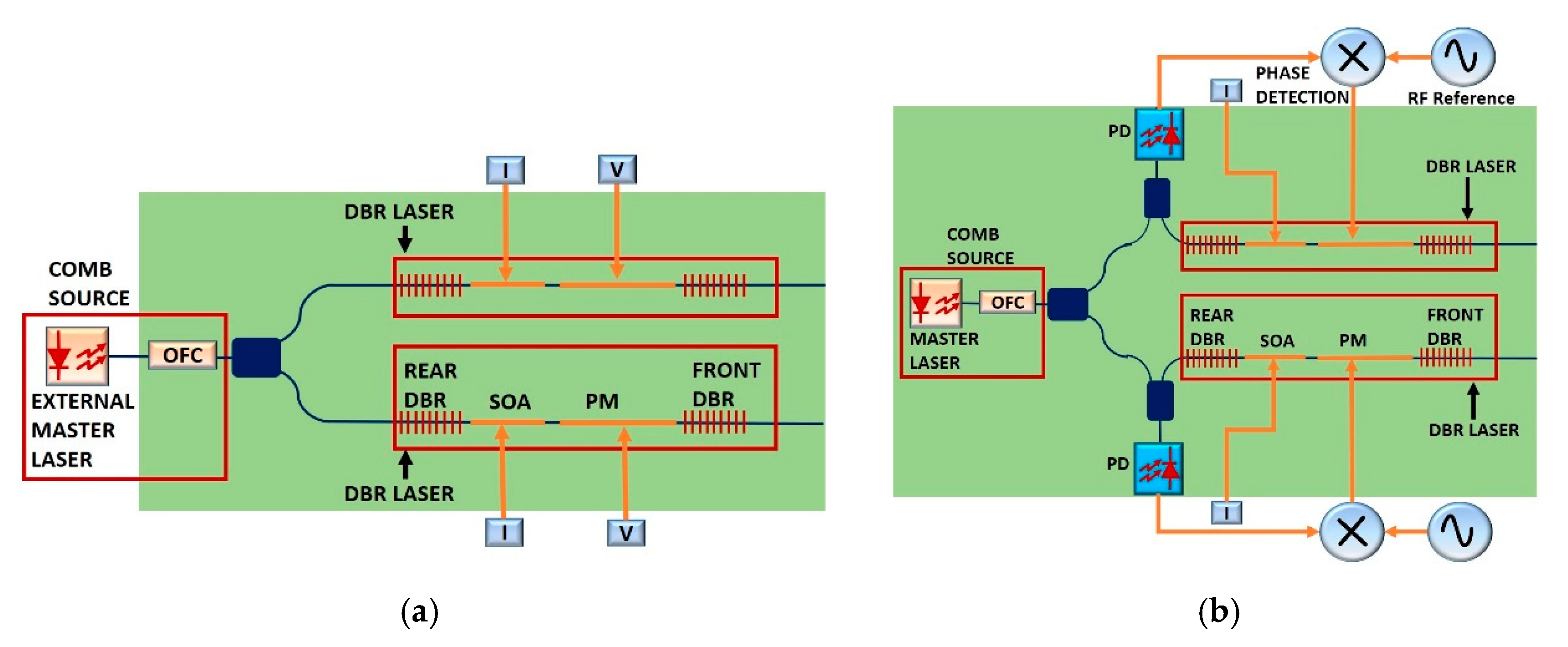
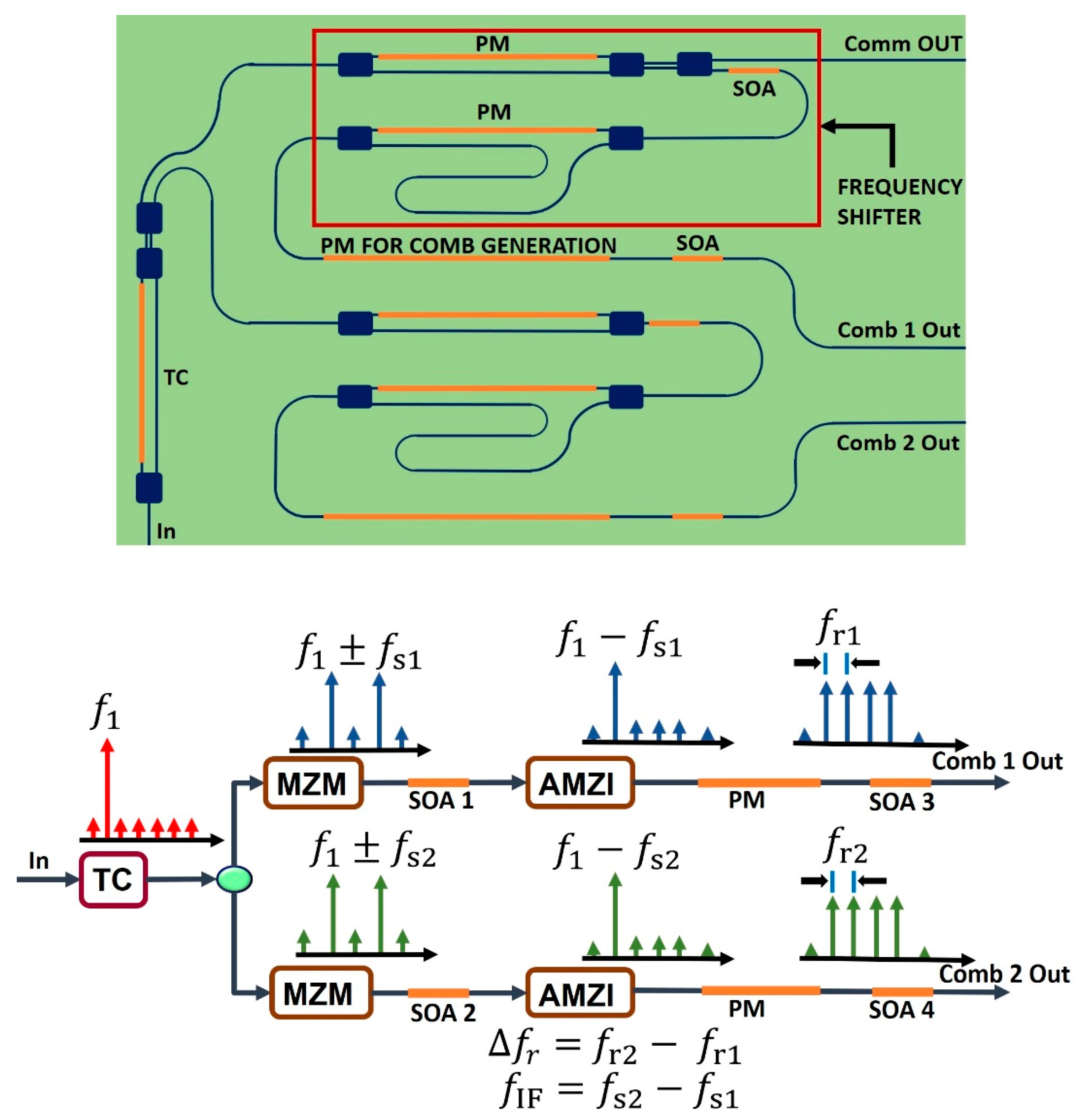

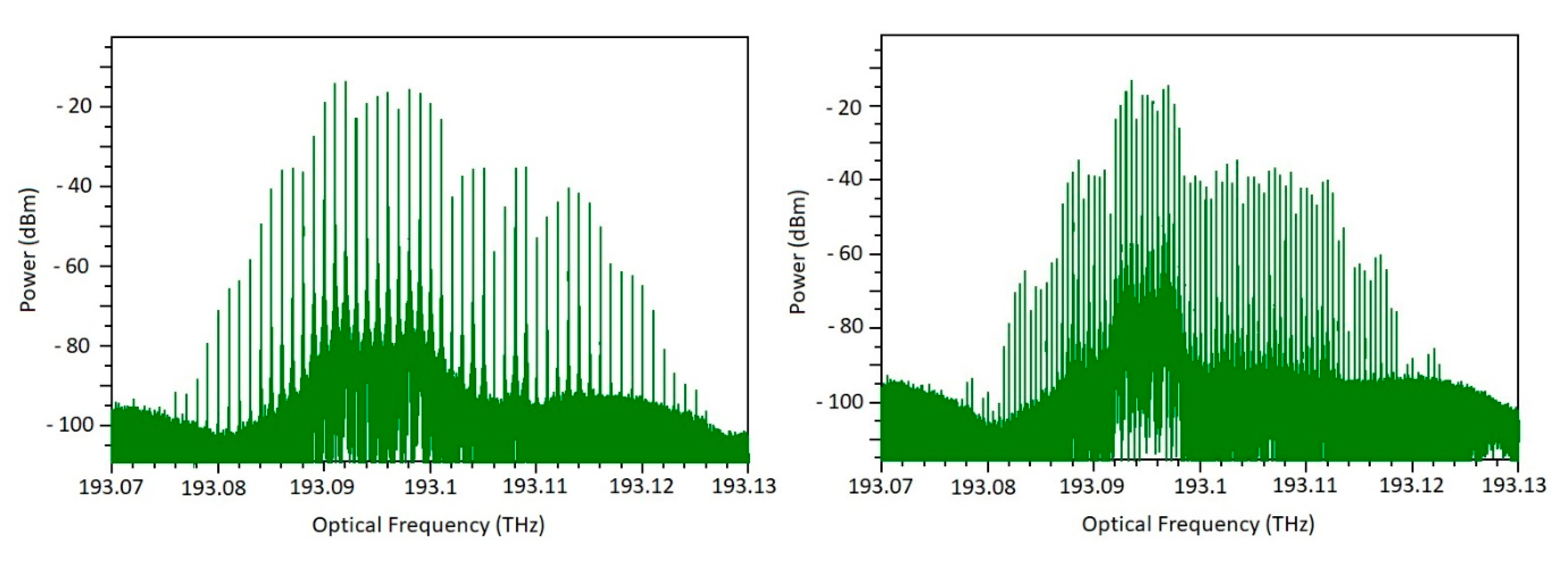

© 2020 by the authors. Licensee MDPI, Basel, Switzerland. This article is an open access article distributed under the terms and conditions of the Creative Commons Attribution (CC BY) license (http://creativecommons.org/licenses/by/4.0/).
Share and Cite
Betancur-Pérez, A.; Martín-Mateos, P.; Dios, C.d.; Acedo, P. Design of a Multipurpose Photonic Chip Architecture for THz Dual-Comb Spectrometers. Sensors 2020, 20, 6089. https://doi.org/10.3390/s20216089
Betancur-Pérez A, Martín-Mateos P, Dios Cd, Acedo P. Design of a Multipurpose Photonic Chip Architecture for THz Dual-Comb Spectrometers. Sensors. 2020; 20(21):6089. https://doi.org/10.3390/s20216089
Chicago/Turabian StyleBetancur-Pérez, Andrés, Pedro Martín-Mateos, Cristina de Dios, and Pablo Acedo. 2020. "Design of a Multipurpose Photonic Chip Architecture for THz Dual-Comb Spectrometers" Sensors 20, no. 21: 6089. https://doi.org/10.3390/s20216089
APA StyleBetancur-Pérez, A., Martín-Mateos, P., Dios, C. d., & Acedo, P. (2020). Design of a Multipurpose Photonic Chip Architecture for THz Dual-Comb Spectrometers. Sensors, 20(21), 6089. https://doi.org/10.3390/s20216089




